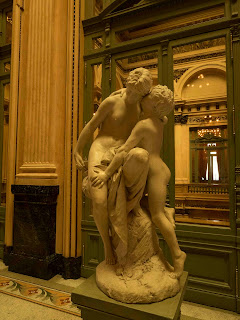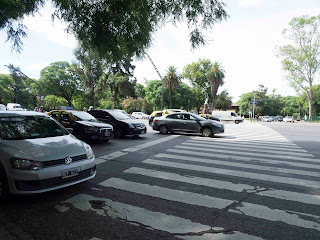Jeri was doing much better this morning. Not 100% but well enough to see B.A. We were picked up at our hotel this morning
by Claudia, our guide for the first half of the day for a tour of Jewish sites
in B.A. Claudia gave us quite a bit of general
history of Argentina and also history regarding the role that Jews played in
the founding of Argentina and Buenos Aires.
(If you are not interested in the history, or your eyes start
glazing over, skip the next few paragraphs)
Argentina was originally populated by peoples closely related to
the Native North Americans, having crossed the Siberian land bridge. Amerigo Vespucci was the 1st
European to explore the area in 1502. It
was thought at the time that there were vast silver deposits here ripe for the
taking. This is how Argentina
(argent=silver in Latin) and Rio de la Plata (river of silver in Spanish
separating Argentina from Uruguay) got their names. No silver actually ever existed in
Argentina. Oops!
Buenos Aires was initially founded at the mouth of the Rio de la
Plata in 1536, but was abandoned a few years later after attacks by the
indigenous population. It was
re-established in 1580 and soon became a major trade center in South America.
In 1816, Argentina formally declared independence from Spain and
after a tumultuous early 19th Century, became an economic
powerhouse. By 1908, it was the 7th wealthiest nation. A good part of the economic good fortune was
probably due to liberal economic policies as well as policies that encouraged
immigration. In the 1880’s, the
Argentinian president Julio Rocca encouraged European immigration, and
Argentina’s massive wave of immigration was second only to that of the U.S. in
this period.
As with much of the world, the Great Depression had a major
political impact on Argentina. Military
coups toppled the government and the economy waned. At the end of WWII
(throughout which Argentina remained neutral), Juan Peron was elected
president, and made sweeping social reforms making him extremely popular with
the general population. After his wife
Eva Peron (Evita, who was even more popular-think Madonna) died, he was
reelected, but after an a failed attempt on his life by the Navy in 1955, he
resigned and exiled himself to Spain. There
ensued a tumultuous period of military juntas and questionable elections. Peron
eventually returned with his third wife, Isabel Peron, a cabaret dancer and
running mate to the presidency in 1973, but died a year later leaving the
country in the incapable hands of his wife.
More military rulers followed, and finally the ill-fated war against
Britain over the Falkland Islands finally led to a period of stable democracy
that the argentines presently enjoy.
Jewish conversos, or
secret Jews, came to the Americas in the 1500’s to escape the Inquisition in
Spain and Portugal. Nearly all of these
original Jews eventually intermarried or converted and there are virtually no
traces of this original population.
There were Sephardic Jews from Spain, Portugal, North Africa that came
later as merchants, but the bulk of the Jewish population came from Eastern
Europe during the same period that we witnessed the mass immigration in the
U.S. Jews of Eastern Europe were
escaping the pogroms in Russia and Poland, and the rampant anti-Semitism in the
rest of Europe. These early settlers
came as farmers, though they knew nothing about farming. They initially did very poorly, but
eventually with hard work and the philanthropy of Baron Maurice de Hirsch, they
began to thrive as Jewish gauchos (“Bucky Goldstein”?) and after a couple of
generations, pushed their children from farming to professions in the city,
primarily Buenos Aires.
Periods of enlightenment and tolerance were intermixed with periods of
anti-Semitism, some state sponsored.
Because of several incidents, there was a large emigration of the Jewish
population to the U.S. and Israel. It
now stands at about 181,000 down from about 300,000 in the 1960’s. It is still the 3 largest in the Americas,
and 7th in the world.
( HISTORY LESSON OVER)
Our first stop, interestingly enough, was the Cathedral of
Buenos Aires. The cathedral was
specifically designed to show the world that Argentina promoted religious freedom
and brotherhood (at least early on).
The
exterior did not look like a typical Catholic church and the frieze above the
front columns depicted a scene from the Old Testament of Joseph reconciling
with his brothers.
Inside the cathedral each of the archbishops of Argentina are
buried. The Archbishop who served prior
to the present Pope was the last to be interred here. Per his request, his burial alcove was
designed as a memorial to those that died in the two car bomb terrorist attacks
in Buenos Aires in 1992 and 1994 that targeted Jews.
Nearby, we passed the Teatro de Colon. The Teatro Colón is the main opera house in Buenos Aires,
Argentina. It is ranked the third best opera house in the world by National
Geographic, and is acoustically considered to be amongst the five best concert
venues in the world.
We also visited the AMIA Building (housing the offices of most
of Jewish organizations in Argentina) site where 85 people were killed in
1994. The building was rebuilt after the
attack, away from the street. The building
is heavily guarded and protected by cement blocks in front to deter suicide car
bombers. Security is so tight here that
photographs of the outside of the building are prohibited (Dave found this out
after he took one), and the security guard crossed the street to question
Claudia about why we were loitering there (even though she is there on a daily
basis).
Our next stop was the site of the Israeli Embassy until 1992
when it, too, was destroyed by a car bomb.
The embassy was rebuilt elsewhere in the city, but the city of B.A.
built a memorial here to the 29 that died.
There is a tree for each of the victims.
Our final site was the synagogue Templo Libertad (or the
Central Synagogue of Buenos Aires) built in 1932 and
still in use. There is a museum attached
to the synagogue that reminded us of the Jewish Museum in Athens.
After the morning history lesson concluded, Claudia dropped us
off at the Ricoleta Cemetery, where the rich and famous of Buenos Aires are
planted. The monks of the Order of the Recoletos arrived in this area, then the
outskirts of Buenos Aires, in the early eighteenth century. The cemetery is
built around their convent and a church, Our Lady of Pilar (Iglesia de
Nuestra Señora del Pilar), built in 1732. The order was disbanded in 1822,
and the garden of the convent was converted into the first public cemetery in
Buenos Aires.
The Ricoleto monks planted a rubber tree in the Plaza Francia in front
of the church around 1800. The tree, “Gomero
Grande”, now measures 60’ high and over
150’ in diameter. The branches are so spread
out that supports are needed to prevent them from breaking.
The entire cemetery is laid out in sections like city blocks, with wide
tree-lined main walkways branching into sidewalks filled with mausoleums.
 |
| Ricoleto Cemetery Entrance |
It is quite amazing, with
“streets” lined by one ornate mausoleum after the other. Presidents and wealthy families seemed to try
to outdo one another for the fanciest final abode.
Two mausoleums are worth mentioning. The first is interesting because it has both
a crucifix and a Jewish menorah displayed prominently. The story goes that the person buried here
found out about his Jewish heritage and wanted to make a statement.
The second, and most visited, is that of Evita Peron, in the
Duarte family mausoleum.
Shortly after
Evita died at age 33 of uterine cancer, there was a military coup, and the
junta attempted to eliminate everything related to Juan Peron and his
family. Evita was much beloved by the
people of Argentina (all of this you could learn by watching “Evita” thanks to Andrew Lloyd Weber), and after she
died the military dictator did not want her buried in Argentina, concerned that
her grave could be a rallying point for rebellion, so they moved her from one
site to another and eventually she was buried in Spain. When Juan Peron returned from exile as
President, he brought Evita’s body back to Argentina. But another coup after Juan Peron’s death
again put the military in charge and they agreed to allow her to be buried in a
family crypt (Duarte) in the Ricoleta Cemetery.
The poor woman’s body was moved so many times that you’d need a
scorecard to keep track.
After getting a little lost, we met an Spanish teacher (tutoring
English speakers in Spanish) who was very kind and got us on the road toward
the botanical gardens. The roads here
are amazingly wide, in some cases as much as 13 lanes (in one direction!).
It can take so long to cross the street that
you could be in a different time zone.
It makes driving here interesting, even as a passenger. Another interesting bit of driving trivia:
Many intersections have no lights, stop signs, or yield signs. Drivers are suppose to yield to traffic to
your right. Good luck with that.
On our way to the botanical gardens, we stopped at some Japanese
gardens and had lunch. It was weird
eating sushi in Argentina.
By the time we finished lunch and walked the 3-4 miles to the
botanical gardens, Jeri was starting to fade (the 95 degrees and strong sun
didn’t help), so we walked back to the hotel and left the Weinsteins and the
Siegels to explore the botanical gardens.
Molly, Dave, Jeri, and I had plans to have dinner and see a
tango show. The tango is the national
dance of Argentina. For dinner we had
steak, yet again (our cholesterol must be hovering around 250), and then across
the street for the tango. The dancers
were fantastic, and just to mix it up, they had a couple of vocalists, and an
Andean group that had a flute to keep away the giant hamsters (South Park).
The tango is a very sensual dance, and the way this group did
it, very physical as well. It supposedly developed from the brothels in the
late 19the century. The performance went
until about 11:45, and we were beat.
Long day tomorrow, heading home in the evening.












































